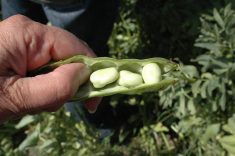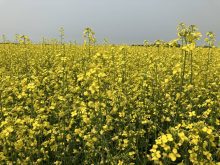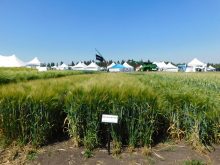STAFF |INDIANAPOLIS
Dow AgroSciences has taken Albert Einstein’s observation – “in the middle of difficulty lies opportunity” – to heart.
Dow AgroSciences is pumped about the products it is developing to meeting growing world food demands from finite resources amidst a changing climate.
There are 6.8 billion mouths to feed now; by 2050 there will be 9.3 billion. An estimated 3.5 billion people will be short of water by 2025. Seventy-one per cent of the water used in the world now goes to agricultural irrigation. Farmers will have to produce more with less water.
Read Also

New crop insurer policy enables easier startup for faba beans
Agriculture Financial Services Corporation updated its normals for faba beans, which may open the door for more Canadian producers to feel comfortable growing the pulse crop in the future.
“We really believe in these mega trends,” Tim Hassinger, Dow AgroSciences’ global business unit leader, told Canadian agricultural reporters during a Dow AgroSciences-sponsored tour Sept. 21.
“We see global constraints – obviously land being one and water being second. What this leads to is a tremendous need for increased productivity and ultimately yield.”
Now ranked the fourth-or fifth-largest pesticide/biotech firm in the world, Dow expects to be among the top three through its research and development efforts.
The company recently began a $340-million expansion to its research and development facilities at its headquarters here, including 14,000 more square feet of greenhouses.
By 2012, Dow AgroSciences will have doubled its capital spending on research and development over 2006 levels, Hassinger said. Although Hassinger said the company’s capital budget is at unprecedented levels, he declined to reveal the numbers.
Eighty per cent of the company’s revenue currently comes from pesticide products and 20 per cent from seeds and traits. The goal is to reach 50-50.
“This is the best pipeline that we’ve ever had,” Hassinger said. “We’re incredibly excited.”
2,4-D-tolerant crops
That pipeline includes a new genetically modified trait to make corn, soybeans and cotton tolerant to the broadleaf weed killer 2,4-D and to ‘fops’ (aryloxyphenoxypropionate), a grass herbicide.
When plugged into Roundup Ready crops DHT (Dow Herbicide Tolerant), will return much of the effectiveness and convenience farmers battling glyphosate-resistant weeds have lost, Hassinger said.
The new trait could eventually be placed in canola.
“We’re not looking to replace glyphosate, we sell glyphosate,” said Scott Hutchins, Dow Agro- Sciences’ director of global crop protection R&D. “We’re looking to find a way to complement the treatment and grow the overall business and maintain the convenience that farmers have come to expect (with Roundup Ready crops).
In addition to its new DHT trait, which it will licensed to other seed companies, Dow AgroSciences has some new range and pasture herbicides coming, and is working on commercializing a new wheat herbicide, a new insecticide and a new fungicide.
They should hit the market in five or so years.
New wheat herbicide
Dow’s new wheat herbicide is a non-ALS broad-spectrum, broadleaf weed killer.
“We feel this active (ingredient) will integrate into our portfolio of actives and we will use it as a building block to create new products that will out perform the products currently on the market,” Kelly Bennett, Dow AgroSciences’ portfolio leader for cereal herbicides in Canada said in an interview.
The active ingredient in Dow AgroSciences’ new insecticide is sulfoxaflor and it will control a wide range of sap-feeding insects such as aphids, Hutchins said.
“Sulfoxaflor is going to be a block-busting product in my estimation,” he said.
It takes up to 10 years to commercialize a new pesticide and costs up to $245 million. That’s why Dow AgroSciences won’t unless it believes a new crop protection product has at least a 20-year life.
The company has two new “novel chemistries” for protecting wheat from septoria, as well as curing plants infected by the fungal disease.
One of the new fungicides comes from a natural product. Commercialization is expected by 2014.
Dow AgroSciences is also working to improve its Nexera canola and sunflower oils. Nexera oil has the stability to replace unhealthy, trans fat-laden, hydrogenated oils. But the firm is working on making Nexera oil even healthier by reducing its saturated fat content and improving the type of Omega-3 it has.














